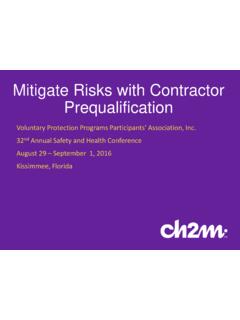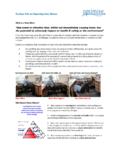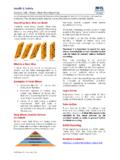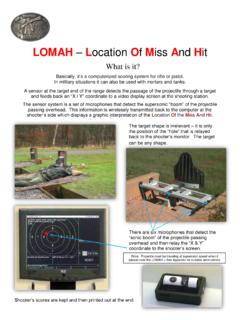Transcription of The Continuous Improvement Benefits of Incident Reporting
1 The Continuous Improvement Benefits of Incident Reporting MSA Hanford RJ Debevec, Rocky Simmons, Gordy Denman1 ShareWhat was the injury that occurred most frequently at your site in 2016/2017? Strains Sprains Overexertion Slips Trips & FallsWhat was the most serious injury in this classification? Report Only First Aid Recordable Days Away2 ChallengeMSA had an increase in recordable injuries in 2015/2016 Implemented Actions: Additional management presence in field (accessibility/availability). Safety Reset All employee meetings to encourage awareness and gather feedback.
2 Provided a series of presentations (Walking Through Life) regarding situational awareness in an effort to reduce severity of had an increase in recordable injuries in 2015/2016 Re evaluation: Mid-course correction to improve safety performance successful. Honest Reporting allows MSA to attend to the areas of focus. Monthly data input can be used as leading indicators. Current Results: In 2017 some of these actions paid off as MSA's current Total Recordable Case/Days Away Rate (TRC/DART) reduced to TRC = = TRC/DART rates have decreased while injury Reporting has increased.
3 Improved safety conscious work force where employees are not afraid to report injuries, no matter how minor. 4 Continuous Improvement Engaging the workforce with important safety conversations and follow-through has allowed us to gain a better knowledge of what is happening in the field (conditions, issues, experiences). As we have encouraged workers to report these issues you can see the decrease in severity rates and overall injuries. This is important to our work now and in the future. Our presentation will walk through this process of trust, value and endearing care for each other.
4 If companies adopt a seamless, transparent Reporting system that encourages communication instead of Reporting , studies have shown that employees are willing to share experiences, and as a result, all information flows of Reporting Benefits of Reporting all accidents, incidents, near-misses and hazards: Investigations(where appropriate) can be performed, and action taken to prevent a recurrence of the Incident . Trend analysesof the collected information can be performed, allowing the organization to focus preventative efforts on areas of most concern. A formal record is keptfor the company and employee, should it be required at a later date as evidence that the event took place.
5 Supports legal requirementsconnected to injury classification, and workers' of Reporting Benefits of having a near-miss Reporting culture: Enables companies to pro-actively resolve hazards before a tragic or costly Incident occurs. Engages the workforce (all workers at all levels) in solving problems. Increases safety ownership and reinforces workers' self-esteem. Uncovers valuable information that otherwise might not be discussed. Develops a positive and engaging attitude surrounding safety. When it comes to creating a near-miss Reporting culture, everyone plays a key role in communication, education and awareness building of Reporting An independent study analyzed 1,752,498 accidents reported by 297 cooperating companies representing 21 different industrial groups with over 3 billion work hours during the study.
6 The study uncovered the following ratios in accidents reported: For every reported major injury (resulting in fatality, disability, lost time or medical treatment) there were reported minor injuries (requiring first-aid), property damage accidents, and 600 incidents. These ratios represent accidents reported and incidents discussed not what actually occurred. 8 Benefits /Value of Reporting9 This study was not intended to predict the ratio of injuries for any particular occupational group or organization. The study found that major injuries are sporadic and unpredictable.
7 Implement corrective actions to address minor incidents (first aid/near miss) to decrease occurrences of major incidents. This assumes a robust work planning process is in place for high hazard of Reporting10 MSA Reporting RealityMSA Reporting Period 2014 2017 Over 2000 MSA employees 4 Million hours worked annually ~750 Safety log entries ~1100 Health & safety inspections documented ~2500 Opportunities for Improvement documented114790 EstimatedUnsafe Acts / Unsafe Conditions479 Report Only / First Aids46 Recordable Injuries31*DART0 Fatalities* Increased DART injury classifications due to physical requirements of 25% of MSA workforce (fire fighters, security forces).
8 MSA Reporting Reality12 Decreasing RatesIncreased 2014FY 2015FY 2016 FYTD 2017 RateTRC and DART by Fiscal YearTRCDART2030405060708090100110120FY 2014FY 2015FY 2016 FYTD 2017 Number of ReportsReporting Comparison by Fiscal YearFirst AidsReport OnlyThe Reporting Results The previous charts show, over a period of time, an improving trend in employees willingness to report injuries. Even though the reports of injuries and first aid cases have doubled in two years of Reporting , the rates of significant injuries (TRC/DART) have declined. MSA continues to develop metrics that demonstrate the culture of safe behaviors throughout the company.
9 13 The Reporting Results MSA management encourages the Reporting of all injuries without fear of reprisal Results indicate that employees feel free to report all injuries regardless of how minor. By Reporting all injuries, MSA is able to study & analyze the data for common themes, address emerging issues as necessary, and implement preventive measures that mitigate seasonal hazards as well as improving employee awareness of hazards in a timely manner. 14 The Reporting Results Examples of corrective actions that MSA implemented to avoid a serious injury or continuation of a series of minor injuries: Workers used stop work authority on a site excavation to re-assess the hazards.
10 It was determined that using guzzler tool instead of manually digging the hole was safer. By using the Hierarchy Of Controls (HOC) process, efficiency of the work improved while reducing the hazard. There were no injuries and the job was completed safely. A lesson learned generated. Integrated Safety Management System using the right tool for the Reporting Results Example of corrective actions that MSA implemented to avoid a serious injury or continuation of a series of minor injuries: Patrol was experiencing a high number of back injuries (strains and sprains) while performing daily job position requirements.










